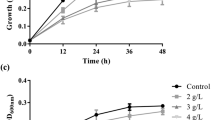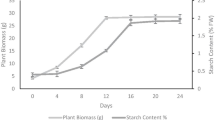Abstract
The depletion of nonrenewable fossil fuels and the rise in their prices depicts that there is a need to fend for alternative fuel resources. Biofuels are one of these renewable alternative options. Among biofuels, bioethanol is one of the most widely used transportation fuels around the world. However, currently, bioethanol is produced from food crops, which is raising food versus fuel feud. Spirodela polyrhiza is one of the novel feedstock that can be used to produce bioethanol at large scale without causing any food and fuel competition. This study involves the collection of S. polyrhiza from a local pond and establishment of its growth in Hoagland growth media. The plant was then given nutrient starvation stress to enhance its starch content by 78%. The high-starch-containing plant biomass was acid-pretreated, and 99.3% starch-to-glucose conversion was achieved. In order to ferment plant sugars, yeast strain Saccharomyces cerevisiae QG1 MK788210 was indigenously isolated and statistically optimized using Plackett–Burman and central composite design to achieve high ethanol yield. The fermentation of plant sugar by Saccharomyces cerevisiae QG1 MK788210 resulted in 100% ethanol yield thus successfully achieving complete conversion of S. polyrhiza starch to bioethanol. The study conducted demonstrates effective optimization of indigenously isolated yeast strain S. cerevisiae QG1 MK788210 to deliver high ethanol yield from S. polyrhiza. Further, this study has been successful in delivering a process for complete conversion of starch from nutrient-starved S. polyrhiza biomass into bioethanol.






Similar content being viewed by others
Availability of the data
The data generated and analyzed during the study is provided in the article [and its supplementary information file].
References
Rana Q, Rehman MLU, Irfan M, Ahmed S, Hasan F, Shah AA, Khan S, Badshah M (2019) Lipolytic bacterial strains mediated transesterification of non-edible plant oils for generation of high quality biodiesel. J Biosci Bioeng 127(5):609–617
Nilsson LJ, Johansson TB (2017) Environmental challenges to the energy industries. In: Sustainable development and the energy industries. Routledge, pp 47–80
Rana QUA, Irfan M, Ahmed S, Hasan F, Shah AA, Khan S, Rehman FU, Khan H, Ju M, Li W, Badshah M (2019) Bio-catalytic transesterification of mustard oil for biodiesel production. Biofuels 1–8
Manochio C, Andrade B, Rodriguez R, Moraes B (2017) Ethanol from biomass: a comparative overview. Renew Sust Energ Rev 80:743–755
Hirani AH, Javed N, Asif M, Basu SK, Kumar A (2018) A review on first-and second-generation biofuel productions. In: Biofuels: greenhouse gas mitigation and global warming. Springer, pp 141–154
Sarris D, Papanikolaou S (2016) Biotechnological production of ethanol: biochemistry, processes and technologies. Eng Life Sci 16(4):307–329
Rodionova MV, Poudyal RS, Tiwari I, Voloshin RA, Zharmukhamedov SK, Nam HG, Zayadan BK, Bruce BD, Hou H, Allakhverdiev SI (2017) Biofuel production: challenges and opportunities. Int J Hydrog Energy 42(12):8450–8461
Michael TP, Bryant D, Gutierrez R, Borisjuk N, Chu P, Zhang H, Xia J, Zhou J, Peng H, El Baidouri M (2017) Comprehensive definition of genome features in Spirodela polyrhiza by high-depth physical mapping and short-read DNA sequencing strategies. Plant J 89(3):617–635
Cui W, Cheng J (2015) Growing duckweed for biofuel production: a review. Plant J 17:16–23
Cheng JJ, Stomp AM (2009) Growing duckweed to recover nutrients from wastewaters and for production of fuel ethanol and animal feed. Clean–Soil Air Water 37(1):17–26
Hashmi M, Khan TK, Khan W, Hasan F, Hameed A, Khan S, Badshah M, Shah AA (2018) Comparison between a newly isolated yeast strain and Lalvin EC-1118 for enhanced ethanol yield from sugarcane molasses employing batch and modified fed-batch fermentation. J Biobased Mater 12(1):134–142
Ruriani E, SUNARTI TC, Meryandini A (2012) Yeast isolation for bioethanol production. HAYATI J Biosci 19(3):145–149
Banat IM, Nigam P, Marchant R (1992) Isolation of thermotolerant, fermentative yeasts growing at 52 C and producing ethanol at 45 C and 50 C. World J Microbiol Biotechnol 8(3):259–263
Stirling D (2003) DNA extraction from fungi, yeast, and bacteria. In: PCR protocols. Springer, pp 53–54
Singh V, Pandey B, Suthar S (2018) Phytotoxicity of amoxicillin to the duckweed Spirodela polyrhiza: growth, oxidative stress, biochemical traits and antibiotic degradation. Chemosphere 201:492–502
Appenroth K-J, Krech K, Keresztes A, Fischer W, Koloczek H (2010) Effects of nickel on the chloroplasts of the duckweeds Spirodela polyrhiza and Lemna minor and their possible use in biomonitoring and phytoremediation. Chemosphere 78(3):216–223
Huang M, Fang Y, Xiao Y, Sun J, Jin Y, Tao X, Ma X, He K, Zhao H (2014) Proteomic analysis to investigate the high starch accumulation of duckweed (Landoltia punctata) under nutrient starvation. Ind Crop Prod 59:299–308
Tao X, Fang Y, Xiao Y, Y-l J, Ma X-r, Zhao Y, He K-z, Zhao H, Wang H-y (2013) Comparative transcriptome analysis to investigate the high starch accumulation of duckweed (Landoltia punctata) under nutrient starvation. Biotechnol Biofuel 6(1):72
Ho S-H, Huang S-W, Chen C-Y, Hasunuma T, Kondo A, Chang J-S (2013) Bioethanol production using carbohydrate-rich microalgae biomass as feedstock. Bioresour Technol 135:191–198
Miller G (1959) Modified DNS method for reducing sugars. Anal Chem 31(3):426–428
Yu J, Zhang X, Tan T (2009) Optimization of media conditions for the production of ethanol from sweet sorghum juice by immobilized Saccharomyces cerevisiae. Biomass Bioenergy 33(3):521–526
Dombek K, Ingram L (1986) Magnesium limitation and its role in apparent toxicity of ethanol during yeast fermentation. Appl Environ Microbiol 52(5):975–981
Arora R, Behera S, Sharma NK, Kumar S (2017) Augmentation of ethanol production through statistically designed growth and fermentation medium using novel thermotolerant yeast isolates. Renew Energy 109:406–421
Xu E, Wu Z, Jiao A, Jin Z (2018) Effect of exogenous metal ions and mechanical stress on rice processed in thermal-solid enzymatic reaction system related to further alcoholic fermentation efficiency. Food Chem 240:965–973
Benerji D, Rajini K, Rao B, Banerjee D, Rani K, Rajkumar G, Ayyanna C (2010) Studies on physico-chemical and nutritional parameters for the production of ethanol from Mahua flower (Madhuca indica) using Saccharomyces Cerevisiae—3090 through submerged fermentation (SMF). J Microbial Biochem Technol 2:46–50
Manikandan K, Viruthagiri T (2010) Kinetic and optimization studies on ethanol production from corn flour. Intl J Chem Biol Eng 3(2):65–69
Jacobs DL (1947) An ecological life-history of Spirodela polyrhiza (Greater Duckweed) with emphasis on the turion phase. Ecol Monogr 17(4):437–469
Xyländer M, Augsten H, Appenroth K-J (1993) Influence of nickel on the life cycle of the duckweed Spirodela polyrhiza (L.) Schleiden. J. Plant Physiol 142(2):208–213
Appenroth K-J, Keresztes A, Sárvári É, Jaglarz A, Fischer W (2003) Multiple effects of chromate on Spirodela polyrhiza: electron microscopy and biochemical investigations. Plant Biol 5(03):315–323
Xing W, Huang W, Liu G (2010) Effect of excess iron and copper on physiology of aquatic plant Spirodela polyrhiza (L.) Schleid. Schleid Environ Toxicol 25(2):103–112
Acknowledgments
The authors are thankful to the Department of Microbiology, Quaid-i-Azam University, Pakistan for providing facilities for this research work and Maliha Elahi for providing the samples of Spirodela polyrhiza. Authors also acknowledge the help provided by Dr. Muhammad Zafar for identification of Spirodela polyrhiza.
Funding
Qurrat ul ain Rana was supported by Indigenous Scholarship granted by Higher Education Commission (HEC) Pakistan.
Author information
Authors and Affiliations
Corresponding author
Ethics declarations
Conflict of interest
The authors declare that they have no conflict of interest.
Additional information
Publisher’s Note
Springer Nature remains neutral with regard to jurisdictional claims in published maps and institutional affiliations.
Electronic supplementary material
ESM 1
(PDF 507 kb)
Rights and permissions
About this article
Cite this article
Rana, Q.u.a., Khan, M.A.N., Irfan, M. et al. Starved Spirodela polyrhiza and Saccharomyces cerevisiae: a potent combination for sustainable bioethanol production. Biomass Conv. Bioref. 11, 1665–1674 (2021). https://doi.org/10.1007/s13399-019-00540-z
Received:
Revised:
Accepted:
Published:
Issue Date:
DOI: https://doi.org/10.1007/s13399-019-00540-z




